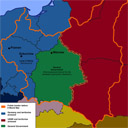0292 The Fate of the Antiquities Collection of Izabela Działyńska (neé Czartoryska)
Identifiers (Article)
Abstract
The collection of antiquities displayed at Gołuchów castle in Poland by Izabela Działyńska was one of the largest private collections in Europe of ancient works of art from the Middle East, Egypt, Greece, and Rome. Ancient pottery, stelae from Cyprus, fragments of Roman marble sculpture, and a large collection of ancient Egyptian artifacts were exhibited in the Greek Vases Hall, the Antiquities Hall, and the Egyptian Hall. The invasion of Poland by Nazi troops on 1 September 1939 and the attack of Soviet troops on 17 September started a two-front war in Poland. On 28 September 1939, the German-Soviet Frontier and Friendship Treaty was signed, marking the border between the two aggressors on Polish lands along the line of the rivers San-Bug-Narew-Pisa. This division of Poland continued until the German invasion of the USSR in June 1941. As a result of these wartime events, the collection of Izabela Działyńska was dispersed. Many of the objects are now in various museums in Poland, but some, including ancient artefacts and other valuable works of art, are considered lost. It cannot be ruled out that some were destroyed.
Statistics


License

This work is licensed under a Creative Commons Attribution-NonCommercial-NoDerivatives 4.0 International License.



